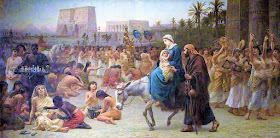 |
| Henri Mauperche, The Rest on the Flight into Egypt French, 1671 Paris, Musée du Louvre |
Adoration of the Christ Child
The final category that I found in my searches is the
subject of the adoration of the Christ Child.
In these images it is most frequently angels who bow down before the
Child in postures of adoration. However,
Mary and Joseph also perform the same actions.
It is somewhat similar to the adoration of the newborn Jesus, but it clearly occurs on the road to Egypt.
 |
| Fra Bartolomeo, The Rest on the Flight into Egypt Italian, c.1500 Pienza, Palazzo Vescovile |
 |
| Pieter Coecke van Aelst, The Rest on Flight into Egypt Flemish, c.1530-1540 Vienna, Kunsthistorisches Museum |
 |
| Annibale Carracci, The Rest on Flight into Egypt Italian, c.1604 Saint Petersburg, State Hermitage Museum |
 |
| Sebastiano Ricci, The Holy Family with Angels, Rest on the Flight into Egypt Italian, c.1700 New York, Metropolitan Museum of Art |
 |
| Giovanni Domenico Tiepolo, The Rest on the Flight into Egypt Italian, c. 1752-1753 Budapest, Szépmûvészeti Múzeum |
 |
| Philipp Otto Runge, The Rest on the Flight into Egypt German, c. 1805-1806 Hamburg, Hamburger Kunsthalle |
 |
| Franz Ittenbach, The Rest on the Flight into Egypt German, 1868 Berlin, Nationalgalerie der Staatlichen Museen zu Berlin |
Four of these images stand out particularly. All come from the century between the latter
part of the seventeenth century and the late eighteenth century and are all the
work of Italian painters.
The earliest, by Giuseppe Bartolomeo Chiari, looks quite
similar to some of the scenes in which angels offer fruit or flowers to the
Child. A kneeling angel offers a basket
laden with objects to the Child Jesus, who is seated on Mary’s lap. He has already removed two objects from the
basket. One is a small wooden cross,
which He holds in His right hand. The
other is a nail, which He holds in His left.
 |
| Giuseppe Bartolomeo Chiari, The Rest on Flight into Egypt with Instruments of the Passion Italian, c.1675 Derbyshire (UK), Calke Abbey, National Trust |
Looking carefully at the basket one can make out some of the other
objects. There are more nails, a whip
and something spikey. What the angel
offers is not fruit or flowers, but the instruments of the Passion. It is a rather shocking reminder of what the
adult life of this Baby refugee would entail. And the eager acceptance by the Child of the cross and nail foreshadow the obedient acceptance of His suffering by the adult Jesus.
The next picture is by Martino Altomonte and depicts angels adoring the Holy Family, who are positioned on the steps of a classical building. One of the pyramids can be seen in the background. Jesus, shown as a little boy rather than a baby, stands in front of the protective arms of Saint Joseph, while Mary sits on a slightly lower step.
 |
| Martino Altomonte, The Rest on the Flight into Egypt Austrian, 1737 Ljubljana, Narodna Gelerija Slovenije |
Above them, in the sky, is a glory of clouds
and angels surrounding God the Father who leans upon the globe of the world and
points downward to where the dove of the Holy Spirit hovers above the earthly
scene.
This is an incorporation of the
iconographic type called The Two Trinities, of which the central figure is
Jesus, the Second Person of the Holy Trinity and the cause of the earthly Holy
Family. It also stresses Saint Joseph's role in the earthly family as the human stand in for the Heavenly Father.
The third picture is by Pompeo Batoni. It shows the sleeping Mother and Child, seated on a portion of a ruined building. Jesus holds a small cross in His hand. He is cradled by Mary, who is also asleep, watched over by Saint Joseph. At the right of the picture are two angels, one with hands crossed in adoration, the other swinging a thurible and incensing the sleeping Mother and Child, just as the consecrated Host is incensed during Mass.
 |
| Pompeo Batoni, The Rest on the Flight into Egypt Italian, c.1740-1749 Dundee, Dundee Art Galleries and Museums Collection (Dundee City Council) |
The final picture makes the connection with the Eucharist even clearer. This is a picture by Corrado Giaquinto, painted in 1764 as part of a series of scenes from the life of Mary for the sacristy at the church of the Franciscan Minims of San Luigi di Palazzo, the royal monastery in Naples, and now in the Detroit Institute of Art.1
 |
| Corrado Giaquinto. The Rest on the Flight into Egypt Italian, c. 1764-1765 Detroit, Institute of Arts |
A slightly different variation, probably a
preparatory sketch, is in a private collection and can give a simpler version of the scene.
 |
| Corrado Giaquinto, The Rest on the Flight into Egypt Italian, ca. 1764 Private Collection |
At the center of
the picture Mary holds the Child (a toddler in this instance) to support Him as
He stands on a slab which bears a resemblance to an altar in a church. With her right hand she gestures to Him with
the same gesture used in the Hodegetria type of image for the Mary as Mother of God, "She who shows the Way".2
Thus we can see that it is with good reason that so many
images of the Rest on the Flight into Egypt were produced over the centuries,
as the image can carry so many diverse meanings.
© M. Duffy, 2017
________________________________
- See Irene Cioffi, “Corrado Giaquinto's ‘Rest on the Flight into Egypt’", Bulletin of the Detroit Institute of Arts, Vol. 58, No. 1 (1980), pp. 4-13.
- See: http://imaginemdei.blogspot.com/2017/01/mary-mother-of-god.html
- See: https://en.wikipedia.org/wiki/Eucharistic_adoration and https://www.osv.com/OSVNewsweekly/ByIssue/Article/TabId/735/ArtMID/13636/ArticleID/15518/Eucharistic-adoration-A-treasure-of-the-Faith.aspx
















































